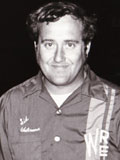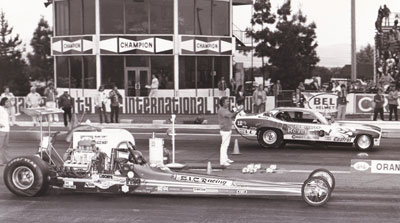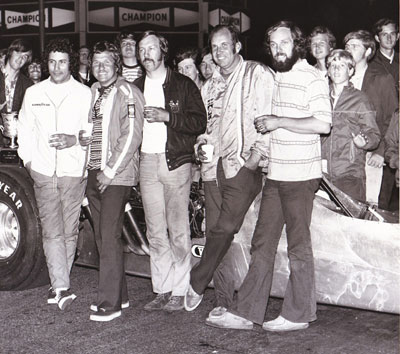

'73 OCIR Constructors Championship: Independents Day

Keith Black
|

Ed Pink
|

Sid Waterman
|
Today's nitro crew chiefs can almost be as big a star as their drivers, household names to many racing fans across the drag racing universe. Guys such as Dale Armstrong, Tim Richards, Austin Coil, and Alan Johnson became legendary for their tuning prowess and were highly coveted – and rewarded – by their team owners. Today, although a lot of glory goes to the driver and his or her name is in the record books, all drivers acknowledge that they wouldn’t have gotten there without their crew chiefs.
Although every racer throughout time has had someone on the crew who was his or her ace wrench – even if it was the racer – the widespread practice of hiring a dedicated crew chief from outside the circle of friends and associates as an engine expert is a fairly recent development in drag racing, probably beginning in the mid-1970s.
In fact, for some teams, engine manufacturers and builders such as Keith Black, Ed Pink, and Sid Waterman not only built their engines but came up with the combinations they dispensed to the teams and maintained some of the cars in their shops between races.
In an interview that drag journo dean Dave Wallace did with "the Old Master," Pink, a few years ago for Hot Rod, Pink noted that his drag racing business crested in those times due to the large number of cars being built and the lack of enough quality tuners to go around.
"The crew chiefs hadn't come in yet," he remembered. "I was kind of the end of that era. We would get the whole deal. We'd take care of the car. The car would be here, we'd hire the mechanics, do the engines. Each time that car left, it had been gone through from front to back, top to bottom. It was like a new car. In those days, as the engine builder, you needed to be really hep on tire pressures, how to set the clutch, what gear to run in the rear end, and how to run the blower. That's why we built the clutches ourselves and did our own blowers. And I hired really good mechanics who were really into what they were doing.
"As time went on, owners started buying parts direct from manufacturers. That cut me out of a lot of business. It slowly got to a point where all we were doing was machine work, a little fuel-injection work, and consultation. Now these guys are pulling their engines apart at the races between rounds, so what do they need me to build?"
Although the engine-builder-as-crew-chief scenario occurred more among the Funny Cars than the Top Fuelers, the importance of these engine builder-cum-crew chiefs and the teams' allegiance to them was nevertheless obvious when Orange County Int'l Raceway unveiled a unique racing concept in May 1973. Fans are well-familiar with such mainstay events as the Manufacturers Meet and East vs. West, but on May 12, OCIR hosted the first Big Four Constructors Championship, a 32-car Top Fuel show pitting customers of Black, Pink, and Waterman and "independent" cars in a team format.
When the race was announced in National DRAGSTER, each builder would have an eight-car team, but by the time the rules were set, there were not limits as to the number of cars from any of the four entities that would make up the field. Points were to be awarded for qualifying, round-wins, and low e.t. and top speed, and should the independents win, the silver cup would go to the motor man of the highest-scoring independent racer.

Randy Allison, sporting Sid Waterman horsepower, was the low qualifier at the 1973 OCIR Constructors Championship with a 6.25.
|
Things started out promisingly enough with a pretty good mix of qualifiers. (Although the reporting of the event in a subsequent issue was not heavy on which cars "belonged" to which engine builder, by trolling through DragList.com, I was able to make some solid deductions.) Low qualifier (6.25) Randy Allison led the field with his Waterman-built powerplant, and Don Prudhomme was second at 6.28 in his Pink-prepped machine, which might be a bit surprising to fans who always have associated Prudhomme with Black from his earliest days in the Greer-Black-Prudhomme and Hawaiian rides. Don Moody, running on Black's team, was No. 3 at 6.31, followed by the Waterman machine of James Warren.
The field sported a lot of familiar names, mostly a Who's Who of West Coast racing, including Frank Bradley, John Stewart (today the tuner for Shawn Langdon), Dennis Baca, Dave Uyehara, Larry Dixon Sr., Gary "Mr. C." Cochran, Tom McEwen (like Prudhomme, Pink-powered in those days), national record holder (6.07) Jim Bucher and his Chevrolet-powered Kenner SSP-sponsored dragster, Billy Tidwell, Dwight Salisbury, Carl Olson, Tony Nancy, Bob Noice, Rick Ramsey, Leland Kolb, and Arley Langlo, who is still competing today and sat in the 32-car bump with a 6.89. Because of the slipshod reporting (not done by the ND staff, by the way <g>), I'm not sure how many of any flavor of engine ended up in the final field.

Ed McCulloch had the only Funny Car to qualify for the 32-car show; he lost in the first round to John Stewart.
|
Of major interest was Ed "the Ace" McCulloch, who was competing in his Pink-powered Revellution Demon Funny Car and qualified 23rd with a 6.72; he lost to Stewart in round one. Gerry Glenn also competed with a Funny Car, the Plueger & Gyger Mustang, after making the field as an alternate, but lost in round one to Les Allen's Pegasus.
Allison fell to tire smoke in the first round, as did Prudhomme, who lost fire after his burnout alongside Tidwell.
The final boiled down to a pair of popular orange-dragster drivers, Moody and Warren, and the title was still on the line.
To reach the final, Moody had worked the Walton, Cerny & Moody entry past a broken Jack McCloud and Phil Soares (Cannon & Soares) with runs of 6.38 and 6.28 (at 233.16, for top speed of the meet) but toasted the clutch on a winning run against Bucher and ran just 7.25. Prudhomme jumped in to help the W-C-M team change the clutch, and they were rewarded with a semifinal victory against Bradley.
Warren ran 6.28 to beat Salisbury and 6.35 to upend Ramsey in Keeling & Clayton's beautiful California Charger, then bashed out low e.t of the race, a 6.18, in round three to beat Dave Russell.
The independents had a lead, and it looked as if only Waterman's team had a chance to catch them, but when Warren went up in smoke against Tidwell in the semi's, all hope seemed lost until "the Ridge Route Terror" expertly pedaled his way past a shocked Tidwell for the win, 7.04 to 7.22.
That made the score 25-23, with the independents out front and Waterman's hopes riding on Warren, who needed to win the final round and better Moody's top speed to tie the competition. It never got that far.

Don Moody, near lane, and James Warren were the finalists at the event. Moody soloed when Warren had to be shut off with a fuel leak but crashed on the run.
|

Billy Tidwell, left, was the top-performing independent runner with the tuning of the Skinner Bros. and help from Jim Dunn, second from right.
|
Roger Coburn was forced to shut off the Warren & Coburn Rain for Rent machine when a fuel line burst on the starting line. But the drama wasn't over yet.
Moody launched on his solo on a pass that many thought could have topped Warren's low e.t. mark, but at half-track, an axle sheared, causing his car to veer from the right lane into the left (thankfully not occupied by Warren) and into the guardrail in a shower of sparks, smoke, and flame. Moody was not injured, but the car was totaled, and the fans walked away talking to themselves.
I contacted Moody via e-mail at his home in Thailand, and even 35 years later, he remembers it well. "That night, we had clutch problems all evening and really weren't running very good, that is until the last round," he wrote. "James Warren had shut off on the starting line with a fuel leak; I had planned to just leave the starting line and shut off. Obviously, Wes had fixed the clutch because it left like a rocket, so I went ahead and pulled the [shift] lever; that's when the axle broke. It was the first failure for a Summers Bros. axle. I ended up upside down in the e.t. light and according to Steve Evans (track operator) ran a 9.56 with no speed."
The final score was independents 26, Waterman 23, Black 17, and Pink a very disappointing 5 points considering the lineup of talent inclined at that time to "Think Pink."
The Skinner brothers, wrenches on Tidwell's car (with an assist from "Big Jim" Dunn), were given the Constructors Cup as the highest-scoring independents. After the bye against "the Snake," Tidwell had defeated Bob Bommarito and Baca before falling to Warren in the semifinals.
Although it wasn't necessarily a true battle between the engine builders, it was an interesting and unique concept for a race and gave everyone a little something extra to talk about.



















































